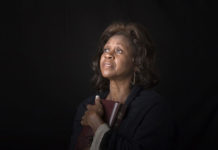I was 14 the first time I stepped through the doors of a real church.
Oh, I’d tramped through countless cathedrals in my early years growing up in Europe. Taken tours, listened to lectures about commissioned artistry, admired stained glass windows and plunked my pennies in the locked offering box.
And I’d occasionally sat through traditional services under a scratchy straw Easter hat swinging my soon-to-be hopelessly scuffed white patent leather Mary Janes.
But those churches seemed set in a different dimension entirely than the church that drew me in, caught my heart and—if I may be so bold—saved my life.
Los Gatos Christian Church met in a refurbished warehouse nestled in the hills near my home. With its redwood walls, load bearing beams and exposed aggregate floors, it looked like no other church I’d ever seen.
And it was packed—wall-to-wall people. And decidedly unchurch-like-loud with the voices of genuinely happy people all shoving past each other to lay claim to a cold metal chair to call their own.
From the moment I walked in those doors I knew I wanted whatever these people had. I wanted in. I wanted to be a part of this, to lay claim to my own seat right in the front row.
And this church, according to the new generation of experts in the know, did it all wrong.
It was, in the derogatory terms that make me cringe, a Big Box church. An attractional model.
And that, in case you didn’t know, is bad—very bad.
Not a small group program in sight.
But for me, what happened every week in that big box felt very much like a massive family reunion. With aunts and uncles and second-cousins-once-removed and a whole cadre of white-haired grandparents who thought I was “so cute, and way too thin, and wouldn’t I love to come for dessert?”
Gosh, they loved me well.
I vividly remember one of my first weeks there when a bunch of kids way too cool for this still-dorky-recent-expatriate invited me to tumble into their fleet of teenage cast-off cars and meet at Farrell’s Ice Cream Parlor.
Believe me, no one in my rich suburban high school had ever invited me anywhere in the months since I’d arrived back on American soil. In my brand new J.C. Penney catalog clothes (the height of fashion in 1970s expatriate Europe) I stuck out like a sore thumb—or a geek—or maybe it was a dork back in those days.
But these kids didn’t care. They just swooped me into their happy world and fed me ice cream.
When the pastor of that church strode over to our waitress-abusing table and, at the behest of the kids, performed his comedic face shaking, spittle loosening imitation of who-knows-what, I was stunned.
And, oh my gosh, he wore a suit! No black robe, no choking clerical collar, just the kind of clothes everyone’s dad wore to work every day back then.
And they called him Marvin. Not reverend, not His Holiness, not even Mister.
Nowadays, the guy would be lashed in blogs and denigrated in seminars bemoaning his CEO status. This was top-down leadership at its peak. But all those leadership faux pas didn’t seem to stop God from using him to change the lives of hundreds—maybe thousands—of people.
And me.
Over time I began to learn the thing that drew these people together and welled up in singing and clapping and laughing and note-taking camaraderie wasn’t a thing at all, but a person.
They told me about Jesus, certain I would want to know. Not in the least bit subtle or seeker friendly.
And I did want to know. And I did want Him. Because if He could create their brand of actual, life-giving happiness in me, well, who wouldn’t do anything to have that?
So I signed on, joined up and started taking notes with everyone else.
Was I genuine? Sincere? Probably not.
Mostly I just wanted to fit in with a fantastic group of new friends. I copied them in every way I could. From the way I held my Bible—a cool new paperback version called The Way—to the sweater I now wore over my skin-baring halter-top.
But before long, my craving for these church people’s approval gave way to a craving for more of this Jesus they so obviously loved. And with their help I learned and grew to understand things I’d never known before.
I began to change, not just on the outside, but somewhere down deep.
I fell in love with Jesus.
I remember sitting at the end of a dock at a camp called Hume Lake. I’d been roused from my bunk by the sound of each of my friends slipping out into the early morning. I knew where they were going and felt that subtle pressure to go there too.
It was my first attempt to try this thing they all did called “a quiet time.”
The words of Matthew drew me in as I underlined, I think, most of the book. I skipped breakfast that day (well, the place was infamous for the glue like oatmeal they served) to power through those words that seemed to come to life.
No wonder most of my friends got up at ungodly hours every morning to do “devotions.” I felt my soul fill up as I feasted on the words.
The day I was baptized, wearing a funky white robe while every one of my friends and new family swayed to the Old Rugged Cross, was the highlight of my life. I filled that baptistery with salted tears of the purest joy I had ever known.
Just remembering the pastor who taught me … the kids who included me … and all the people who loved me … brings back that rush of well-being that comes only rarely in real life.
Why do I love the Church? With all our flaws and failures and inadequacies and ridiculous fads? Because when I needed what they had —
they gave me Jesus.













